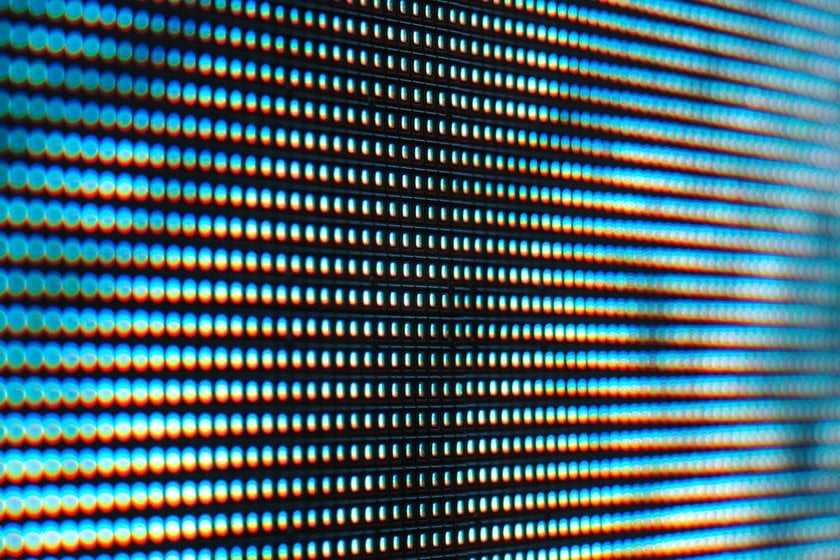Ever spotted an unexpected speck of color that stubbornly sticks around in every shot? That little rebel is a "stuck pixel," a tiny flaw that can be both a photographer's headache and a learning opportunity. Every digital photographer, amateur or pro, might encounter this peculiar issue.
But fear not! In this post, we're going to unravel the mystery of stuck pixels. From spotting these persistent little dots to fixing them with a few clever tricks, we’ll guide you through everything you need to know!
Ready to tackle one of digital photography's tiny troubles? Let’s zoom in and get started!
What is a Stuck Pixel
 What does a stuck pixel look like? It appears as a brightly colored dot — red, green, blue, or a combination — displayed consistently in the same spot across different photos, unlike dead pixels, which are completely inactive and show as black.
What does a stuck pixel look like? It appears as a brightly colored dot — red, green, blue, or a combination — displayed consistently in the same spot across different photos, unlike dead pixels, which are completely inactive and show as black.
Stuck dots are semi-active, receiving constant power and lighting up due to a malfunction in one or more of the photodiodes in the camera's CMOS sensor. This malfunction causes the photodiodes to emit maximum brightness and color, which can sometimes resolve over time, unlike the permanent nature of dead spots.
In a real-world example, a Nikon D80 camera captures an image that, upon close examination at a 100 percent crop, reveals bright blue and white dots, indicating a stuck pixel example. When enlarged to a 3000 percent crop, the effect of the camera's JPEG processing algorithm and Bayer filter can be seen, causing the pixels to bleed out visually. This scenario helps differentiate stuck pixels from other sensor anomalies like dead pixels, which show no light, and hot pixels, which appear temporarily during long exposures.
How to Spot a Stuck Pixel
 Spotting a stuck pixel on your camera might sound tricky, but it's quite straightforward with the right steps. Start by setting your camera to a standard setting like Program/Auto or Aperture Priority Mode and turn on Live View. As you move the camera around, watch the LCD closely for any speck that stubbornly stays the same bright color and doesn't move, even as you shift the camera’s viewpoint. This constant dot of color could indicate a stuck pixel on your LCD!
Spotting a stuck pixel on your camera might sound tricky, but it's quite straightforward with the right steps. Start by setting your camera to a standard setting like Program/Auto or Aperture Priority Mode and turn on Live View. As you move the camera around, watch the LCD closely for any speck that stubbornly stays the same bright color and doesn't move, even as you shift the camera’s viewpoint. This constant dot of color could indicate a stuck pixel on your LCD!
For stuck elements on the camera sensor, the process is a bit different. Take a series of photos at a low ISO, ideally around 100 or 200, to keep the image clean and free from noise. Then, pull these images up on your computer and zoom in to 100%. Look for any persistent colored dots that appear in the same spot across different photos. These are your culprits — stuck pixels, which sometimes show up as a tiny cross on close inspection. It’s pretty common for digital cameras to have a few of these, so spotting them is key to keeping your photos crisp!
Fixing a Stuck Pixel
 In-Camera Solutions
In-Camera Solutions
Fixing stuck pixels directly within your camera can vary significantly based on the brand and model, so it's crucial to start by consulting your camera’s manual or online resources specific to your model.
Many modern cameras come equipped with a pixel mapping feature, which identifies and compensates for stuck specks by ignoring the defective pixel and using data from surrounding ones to correct the image. This method, found in brands like Olympus, can often be activated through the camera's settings menu, allowing the camera to perform a self-diagnosis and repair without needing to send it in for service.
For cameras under warranty, manufacturers often offer a service to map out dead pixels, which might include a professional cleaning — though this can be costly if the warranty has expired, typically running between $100 and $200. If your camera includes an automatic sensor cleaning mode, this can sometimes shake loose dust and even resolve some stuck spot issues by vibrating the sensor at a high frequency. This feature not only helps with general maintenance but might also reduce stuck pixel problems, acting like a gentle massage for the sensor.
Using Software
If in-camera solutions aren’t enough, software can be a powerful tool! Programs like Adobe Photoshop and Lightroom offer tools for retouching images where stuck pixels appear, and Luminar Neo provides an effective Clone Tool that is particularly easy to use for this purpose.
Photoshop Steps:
Open your image in Photoshop: Load the photo.
Zoom in: Find the stuck pixel by zooming into the image until you can see the individual pixels. The one you need should stand out as a brightly colored dot.
Select the Healing Brush Tool: This tool is perfect for fixing small blemishes. You can find it in the toolbar or by pressing the shortcut ‘J’.
Sample an area: Alt-click (Windows) or Option-click (Mac) a nearby area that looks similar in color and texture to the area around the stuck pixel.
Paint over the stuck pixel: Click or paint over the stuck pixel to replace it with the sampled dots, blending it seamlessly into the rest of the image.
Luminar Neo Clone Tool:
Open Luminar Neo: Load the image needing corrections and navigate to the Clone tool located under the Professional tools section.
Set the source: Click on an unaffected area of your image to define the source. Adjust your brush settings, including Radius, Softness, and Opacity, to match the surrounding area’s texture.
Clone out the pixel: Use the brush to paint over the stuck pixel. Employ techniques like dabbing or short strokes for a natural, blended appearance. Adjust the opacity and layer multiple strokes for optimal results.
These software solutions allow for precise control and can be a lifesaver for images affected by stuck pixels, especially when in-camera fixes aren’t feasible. It’s worth exploring both hardware and software options to find the best method for your specific situation!
How to Avoid Stuck Pixels
 Switch to RAW
Switch to RAW
Shooting in RAW is a game changer if you're noticing stuck pixels. Unlike JPEGs, which are processed right in your camera, RAW files keep all the original pixel information. This means that when you edit these photos using programs like Photoshop or Luminar Neo, the software can spot and fix any stuck spots better. It's a bit more work post-shoot, but it’s worth it for cleaner images.
Regular Maintenance and Care
A clean camera is key to avoiding problems. Make it a habit to clean your sensor regularly, and be mindful of the environments you're shooting in — extreme temperatures can mess with your camera's sensor. Simple steps like these can keep stuck pixels at bay.
Camera Settings and Usage
Some settings are more likely to lead to stuck pixels. Long exposures and high ISO settings heat up your sensor and can make those dots stick out. Keeping an eye on your exposure times and ISO can help keep your photos clear and free of unwanted specks. Additionally, leveraging photo editing software can help you make images clearer, giving you even more control over the final result!
These steps are straightforward but effective, helping you maintain crisp, clean images in your photography!
Conclusion
Tackling stuck pixels might seem daunting, but with the right knowledge and tools, you can manage them effectively and keep your photographs looking their best. From understanding what stuck pixels are and spotting them in your images to employing in-camera solutions and powerful editing software, we've covered essential strategies to address and prevent these tiny flaws.
As you continue to explore photography, remember that regular camera maintenance and careful shooting settings play a crucial role in the quality of your images.
And if you're interested in learning more about enhancing your photo skills, check out our posts on topics like portrait and landscape difference — it's super useful for photographers of all levels!
Keep shooting and keep learning; every challenge is an opportunity to refine your craft!



 In-Camera Solutions
In-Camera Solutions Switch to RAW
Switch to RAW